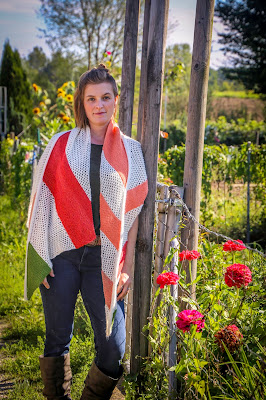 |
| Follow Your Arrow Shawl |
First and foremost: a quick thanks to Nikki from Zender Studios for taking these photos for me; you're a doll for helping (and lending me your shoes for the pictures)! And with that being said, let's get to some details about the pattern...
... like the fact that I should probably apologize for the fact that I made this delightful shawl using mill ends that I bought at the Edinburgh Yarn Festival, which means that I can't tell you *exactly* what's in the thing. However, I CAN tell you that I carefully measured everything I used, and added a 10% allowance to the values below, so you can find grams/yards/meters for every color, which should help you to choose your own materials (just remember: having the appropriate yardage is more important than the weight, especially for colors D & E [since those are my heavier weight yarns]). I also encourage you to view the pattern as a jumping-off point for your own color ideas; overall, it's made of 10 sections with 2 colors apiece, so the possibilities abound!
Speaking of the fact that it's 10 sections (and kite shaped, when laid out!), I should also mention that this pattern has not been tech edited, and since it's one of my lengthier designs I welcome any questions or comments about errors that you may find. Ultimately, it's not terribly complicated since I used the same pattern all over (a combination of garter and a mesh pattern), but once you add color choices and increases and decreases to the thing, I'm certain I slipped in my notation at least a few times. So again, I'm very happy to help with any issues you may find; in fact, I've even labeled each section of the design so that it's easier for you to identify any problems to me (just give me section and row number and we'll be good to go!).
Oh, and I know I'm being verbose today, but one last thing; I noticed, as I worked this, that it's easier to make knitting errors in the sections in which you're beginning with your color A, or the mesh pattern. If you notice that your counts are off, don't despair! This mesh pattern is VERY forgiving of errors, and as long as you correct your stitch counts by the end of each section you will be able to proceed, even if you've made a mistake (and, again, I highly doubt you'll find your error ever again). All in all - bon courage, and I hope you like your finished shawl as much as I like mine (IT'S AMAZING!). Also, if one of you actually makes it in the target yarn (ideally John Arbon Textiles Knit by Numbers 4 Ply) please send me pictures, so I know what it would look like if I didn't have such a strong attraction to the mill ends bin. Of course, even if you make it with a bunch of odds and ends like I did, I think it will turn out great just the same!!! :) (other ideas: scale it up with DK weight yarn and the appropriate sized needles if you'd like, or even worsted it you want a real sleeping bag of a shoulder wrap. and again, send pics!)
Finished Size: 75" long in total, 28" inches wide at the widest point
Yarn: John Arbon Textiles mill ends; White (Alpaca Delight, 70% Alpaca, 30% Merino; Color A; 120 grams, or roughly 510 meters/558 yards), Green (Knit by Numbers 4 ply, 100% Merino; Color B; 8 grams, or roughly 32 meters/35 yards), Orange/Green (unknown fiber; Color C; 30 grams or roughly 120 meters/132 yards), Dark Orange/Red (100% Merino; Color D; 58 grams or roughly 145 meters/159 yards), Light Orange (Knit by Numbers DK, 100% Merino; Color E; 100 grams or roughly 250 meters/274 yards)
 |
| From the side |
Notions: tapestry needle, two stitch markers
Gauge: I am a terrible person and used two different weight yarns in this shawl, as mentioned. Colors A, B, and C are 28 stitches = 4 inches on US 2 needles, the rest are 24 stitches = 4 inches on size US 4 needles. I am loosely averaging this to mean 26 stitches = 4 inches on US 3 needles for all. Like I said, terrible!
So let's get started! Using your color B yarn, cast on 2 stitches. Then, right next to those 2 stitches, use your color A yarn to cast on 3 stitches as well (at this point, that means that these two sets of stitches are not connected). Then, using intarsia color joins for all color changes, we'll begin our first color section like so:
